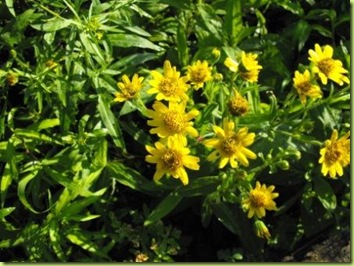This is American arnica, Arnica chamissonis, aka Chamisso arnica, which I purchased as small transplants last spring from Richter’s Herbs. This cheerful, daisy-like little plant is doing beautifully in a section of my garden where I dug out a drainage ditch to carry water away from the foundations of the house. Only about 6 inches tall, it is already bushy and covered with flowers. (Correction: The plant is actually about a foot tall. But it's so sprawly that it appears to be shorter.) Given that it’s a perennial and spreads by rhizomes (but not aggressively so), I’m expecting an even better display in future years.
According to the USDA Plants Database, American arnica likes coarse soils, but this area of my front yard is quite clay-ey, despite my efforts to break up the clay with organic material.
The plants database also says that whereas this arnica doesn’t mind occasional flooding (that’s why it’s in the drainage ditch), it has very little tolerance for drought. Though we had a mostly wet summer, lately it’s been hot and dry here. Yet the little arnica continues to bloom its head off.
And though this plant is a sunlover like most of the daisy-like plants (known to plant nerds as composites), it will tolerate partial shade. So all in all, I’d say it’s a pretty undemanding little plant.
What’s more, the composites are almost all good butterfly plants! The flat surface of the bloom provides an ideal landing area for larger butterflies, allowing them to alight without injuring their wings. The central disc is composed of many small flowers, each with a payload of nectar for the butterfly to drink from.
A. americana is native throughout most of Canada and in the western United States. It is not native to the Maritime provinces where I live, but because it’s native as far east as Quebec I classify it as “nearly native”—good enough for my somewhat lax standards.
This is not the arnica traditionally used in herbal medicine. That arnica is A. montana, a European species. However, Richter’s claims that A. americana may have the same properties as A. montana. Please note that although I occasionally report health claims made on behalf of plants, I don’t endorse or deny these claims. Many plants contain substances that might be either toxic or beneficial depending on who uses them and how they are used—please never use a plant medicinally unless you’re sure you’ve identified it correctly and that you know how to use it. For a brief discussion of research on the medical properties of A. montana, see this entry in the Wikipedia.


No comments:
Post a Comment